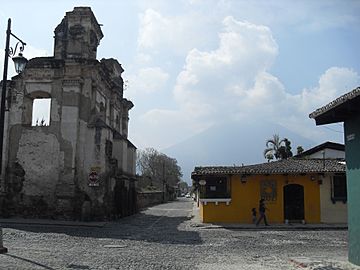1773 Guatemala earthquake facts for kids

A damaged convent near Volcán de Agua
|
|
| Local date | July 29, 1773 |
|---|---|
| Local time | 15:45 |
| Magnitude | ~7.5 Mi |
| Depth | Unknown |
| Epicenter | 14°36′N 90°42′W / 14.6°N 90.7°W |
| Areas affected | At or near Antigua Guatemala |
| Max. intensity | VII (Very strong) - VIII (Severe) |
| Casualties | 500–600 fatalities |
The 1773 Guatemala earthquake was a very strong earthquake that hit Guatemala on July 29, 1773, at 3:45 PM. It was measured at about 7.5 on the magnitude scale. This earthquake was actually part of a series of quakes that began in May of that year.
Before the main quake, there were two strong smaller quakes called foreshocks on June 11. After the main quake, many more smaller quakes, called aftershocks, continued until December 1773. This whole series of earthquakes is also known as the Santa Marta earthquake(s). This name comes from the fact that the quakes started on the feast day of Saint Martha.
The Santa Marta earthquakes were very powerful, causing a lot of damage. They were rated between VII (Very strong) and VIII (Severe) on the Mercalli intensity scale. This scale describes how much people feel an earthquake and how much damage it causes. These quakes destroyed much of Santiago de los Caballeros de Guatemala, which is now known as Antigua Guatemala. At that time, it was the main capital city for Central America.
Around 500 to 600 people died right away because of the earthquake. Sadly, at least 600 more people died later from hunger and sickness caused by the disaster. The earthquake also greatly affected the number of religious workers in the area, especially those from the Mercedarian Order. Their numbers were cut almost in half, and they also lost a lot of their income.
Moving the Capital City
After a big earthquake in 1717, the Spanish leaders had already thought about moving the capital city to a different place. When the 1773 earthquake caused so much destruction, they decided not to rebuild the old city again.
In 1776, the capital was officially moved to a new city called Guatemala of Asuncion. Today, this new city is known as Guatemala City.
See also
- List of earthquakes in Guatemala
- List of historical earthquakes
 In Spanish: Terremotos de Santa Marta para niños
In Spanish: Terremotos de Santa Marta para niños

